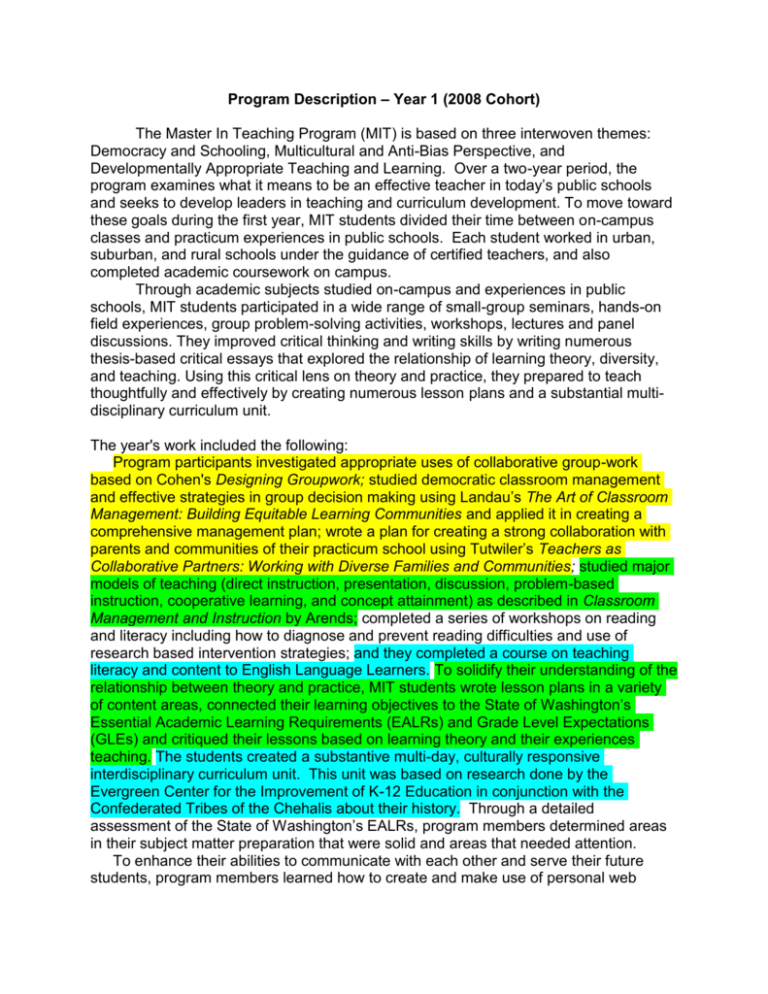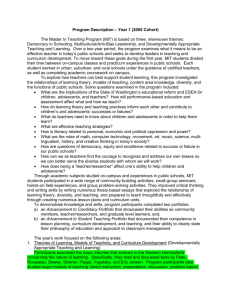The Master In Teaching Program (MIT) is based on three interwoven
advertisement

Program Description – Year 1 (2008 Cohort) The Master In Teaching Program (MIT) is based on three interwoven themes: Democracy and Schooling, Multicultural and Anti-Bias Perspective, and Developmentally Appropriate Teaching and Learning. Over a two-year period, the program examines what it means to be an effective teacher in today’s public schools and seeks to develop leaders in teaching and curriculum development. To move toward these goals during the first year, MIT students divided their time between on-campus classes and practicum experiences in public schools. Each student worked in urban, suburban, and rural schools under the guidance of certified teachers, and also completed academic coursework on campus. Through academic subjects studied on-campus and experiences in public schools, MIT students participated in a wide range of small-group seminars, hands-on field experiences, group problem-solving activities, workshops, lectures and panel discussions. They improved critical thinking and writing skills by writing numerous thesis-based critical essays that explored the relationship of learning theory, diversity, and teaching. Using this critical lens on theory and practice, they prepared to teach thoughtfully and effectively by creating numerous lesson plans and a substantial multidisciplinary curriculum unit. The year's work included the following: Program participants investigated appropriate uses of collaborative group-work based on Cohen's Designing Groupwork; studied democratic classroom management and effective strategies in group decision making using Landau’s The Art of Classroom Management: Building Equitable Learning Communities and applied it in creating a comprehensive management plan; wrote a plan for creating a strong collaboration with parents and communities of their practicum school using Tutwiler’s Teachers as Collaborative Partners: Working with Diverse Families and Communities; studied major models of teaching (direct instruction, presentation, discussion, problem-based instruction, cooperative learning, and concept attainment) as described in Classroom Management and Instruction by Arends; completed a series of workshops on reading and literacy including how to diagnose and prevent reading difficulties and use of research based intervention strategies; and they completed a course on teaching literacy and content to English Language Learners. To solidify their understanding of the relationship between theory and practice, MIT students wrote lesson plans in a variety of content areas, connected their learning objectives to the State of Washington’s Essential Academic Learning Requirements (EALRs) and Grade Level Expectations (GLEs) and critiqued their lessons based on learning theory and their experiences teaching. The students created a substantive multi-day, culturally responsive interdisciplinary curriculum unit. This unit was based on research done by the Evergreen Center for the Improvement of K-12 Education in conjunction with the Confederated Tribes of the Chehalis about their history. Through a detailed assessment of the State of Washington’s EALRs, program members determined areas in their subject matter preparation that were solid and areas that needed attention. To enhance their abilities to communicate with each other and serve their future students, program members learned how to create and make use of personal web pages. During the year, each MIT student prepared and integrated teaching technology into a lesson in her/his endorsement area. In addition, they developed and used their technology skills to locate and document educational research for their masters papers. Based on an understanding of developmental theory and best practices in teaching, MIT students studied curriculum development and methodologies in their specific content areas. Examples of texts used by all students to support the development of their knowledge and skills included: Reading Process and Practice; Understanding by Design; Multicultural and Gender Equity in the Mathematics Classroom; Brain Matters: Translating Research into Classroom Practice; Teaching the Best Practice Way: Methods that Matter K-12; Classroom Instruction that Works with English Language Learners; Widening the Circle: Culturally Relevant Pedagogy for American Indian Children; Place-Based Education: Connecting Classrooms & Communities; Literacy with an Attitude: Educating Working-Class Children in Their Own Self-Interest. Texts used by elementary education students to support the development of knowledge and skills in literacy included: Reading Reminders: Tools, Tips and Techniques; Literacy Moves On: Popular Culture, New Technologies and Critical Literacy in the Elementary Classroom. Texts used by secondary education students to support the development of knowledge and skills in literacy included: In the Middle: New Understanding About Writing, Reading; Learning and Speaking Volumes: How to Get Students Discussing Books-and Much More. MIT students examined their cultural filters and assumptions through reflective writing, discussions, and participation in workshops including panels of relevant guest speakers. Participants examined theories concerning the nature of learning. Specifically, they read and analyzed texts by Plato, Rousseau, Dewey, Skinner, Piaget, Vygotsky, Rogoff, and Noddings. They explored societal beliefs and conditions concerning excellence, equity, democracy, and equality in America's public schools. They also examined the relationships of race, class, gender, ethnicity, and ability to the quality of education students receive. Students read, critiqued, discussed, created workshops, and wrote extensive essays about the ideas and information in texts such as The American School 1492-2006; The Mismeasure of Man; Other People's Children: Cultural Conflict in the Classroom; The Inner Lives of Immigrant Children; The Pact: Three Young Men Make a Promise and Fulfill a Dream; Learning Outside the Lines; Pedagogy of the Oppressed; Ten Little Indians; A White Teacher Talks About Race; Asian Americans in Class: Charting the Achievement Gap among Korean American Youth; Ain’t No Makin’ It; Tongue-Tied: The Lives of Multilingual Children in the Public Schools; “Why Are All the Black Kids Sitting Together in the Cafeteria?” and Other Conversations About Race; Boy Writers: Reclaiming their Voices; “I Won’t Learn from You”: And Other Thoughts on Creative Maladjustment; Beyond Diversity Day: A Q&A on Gay and Lesbian Issues in Schools; No Time to Say Goodbye: Children’s Stories of Kuper Island Residential School. For research and scholarly writing, each student completed an individual research paper on a topic that had the potential to improve her/his ability to serve future students. Students participated in workshops on research design and educational statistics, using the texts Reading Educational Research and Writing Literature Reviews, to support their ability to critique educational research. These papers included a substantial critical review of the relevant literature, summative conclusions and specific recommendations for practice. These papers required graduate-level writing that used the documentation style of the American Psychological Association. These papers will be presented at a conference during winter quarter of the second year of the program and will be published in a conference proceedings book. Faculty: Jacque Ensign Gery Gerst Masao Sugiyama Sherry Walton, Program Director








